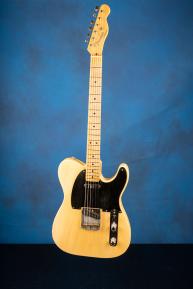A Wonderful Early 1953 Telecaster previously owned
by renowned American Bass Player & Session Musician Bob Glaub
1953 Fender Telecaster
This seventy-two year-old Butterscotch Blond beauty weighs 7.60 lbs. and has a nut width of 1 5/8 inches inches and a scale length of 25 1/2 inches. Single cutaway solid ash body. Wonderful thick profile maple neck (rising from 0.91 behind the 1st and 3rd frets, and the gently rising from 0.95 behind the 5th to 0.98 behind the 12th fret. Twenty-one frets with black dot position markers. The two black dot markers at the 12th position are one-inch apart, center to center - the same as on a '52 Telecaster.The Single "round" string tree has two flat sides underneath and is secured by a single screw. Headstock decal with "Fender" spaghetti logo in silver with black outline and "Telecaster" in black below it. Individual Kluson Deluxe 'single-line' tuners with oval metal buttons. The tuning keys are stamped "2356766/PAT. APPLD" on the bottom base**. One plain metal-cover "black-bottom" pickup with slot-head adjusting screws (at neck) with an output of 6.00k, and one black six-polepiece "copper-coated metal plate bottom" pickup with flush pole-pieces (angled in bridge-plate) with an output of 6.51k. Single-ply black Bakelite pickguard with five screws. Two controls (one volume, one tone) plus three-way "tone" switch and original "patent number" black plastic "barrel-like" tip, all on metal plate adjoining pickguard. Shorter chrome knobs with more pronounced domes and heavy knurled sides. Telecaster combined bridge/tailpiece with three (flat-ground on bottom) brass saddles and slot-head intonation adjustment screws. Serial number "5159" on the bridge plate beneath the words "FENDER/PAT. PEND." The neck is dated in pencil "TG 2-4-53" and the body neck-pocket is dated in pencil "Tadeo / 2-25-53". The potentiometers are stamped "304 221" & "304 235" (CTS May & August 1952**). The three-way switch is stamped "CRL 1452." This guitar is in remarkably fine condition. There are a few small marks and "dings" on the body and some light edge-wear. The neck has been expertly re-fretted by David Eichelbaum with slightly taller (.009) gauge fretwire. There is some light wear to the fretboard, but no divots. The lovely grain of the ash body shows very well through the Blond finish and this seventy-two year-old gem is in excellent plus (8.75) condition and is quite simply one of the nicest 1953 Telecasters that we have ever seen. Complete with the original 'ash tray' bridge cover. Housed in a 1955-1958 Fender tweed case with red plush lining, catches replaced (8.75).
**When we received this fine guitar we noticed that the volume control had been replaced and that the 1MFD capacitor had been removed and replaced with a .001 capacitor. We managed to find another original 1952 volume control which was just 14 weeks later than the original tone control. We also found another correct 1MFD capacitor to replace the later .001 that had been installed. Our luthier has put the circuit back to original 1953 specification with the correct volume potentiometer and the correct 1MFD capacitor. Also the tuners had been replaced with Kluson 'double-line' ca. 1964. We managed to find a period correct set of 1955 kluson 'single-line' tuners with the exception of the 'A' tuner which is correct for 1953. So in summary the guitar has been re-fretted and at the same time a new nut was fitted. Under the baseplate, Three small black rubber grommets have been added to the original rubber ones which are somewhat flattened. The controls are now back to the correct 1953 specification and the tuners have been replaced with 1953 & 1955 originals.
Provenance: Included is a letter from Emerald City Guitars, dated April 2017 stating "This classic and original Fender electric guitar is commonly called the "Blackguard Tele" among guitar collectors and is highly sought after. This particular guitar was acquired by Jay Boone (owner) of Emerald City Guitars from longtime bassist for the Jackson Browne Band, Bob Glaub***. Bob had owned this instrument for over 30 years and it was used often by the members of the band over the years and has been kept in good and original condition. The only changes over the years has been the volume pot after the original simply wore out and the original 50's Kluson tuners were later replaced with mid-sixties Kluson tuners without any alterations to the guitar. The butterscotch finish is intact and shows typical player wear but overall superb condition. All other hardware and electronics are stock. The nut was replaced and the original frets were replaced professionally after they had been worn out. This is an exceptional playing instrument that sounds as good as it looks. We regard this classic vintage Telecaster as one of the finest examples we have had for some time and the Jackson Browne Band connection is a tribute to it's undeniable appeal. It was shipped to us in an original mid-fifties tweed case."
***Bob Glaub (born May 10, 1952) is an American bass player and session musician. He has played with such artists and bands as Dave Mason, Journey, Steve Miller Band, John Fogerty, Bruce Springsteen, Bob Dylan, Neil Diamond, Jerry Lee Lewis, Ringo Starr, Dusty Springfield, Aaron Neville, Linda Ronstadt, Stevie Nicks, Jackson Browne, Warren Zevon, Donna Summer, John Lennon, Rod Stewart, Crosby, Stills & Nash, The Bee Gees and many others.
"Both the Telecaster and the Esquire kept their basic 1951 appointments until the mid-50s. In retrospect, their most striking features -- at least cosmetically speaking -- are a typical yellowed blonde finish (a.k.a. 'butterscotch' finish) and a black pickguard, hence the often cited notion of early 'black guard' Tellies. The combination of the two actually gives a distinct look to the early 50s models, which are otherwise considered by many as the ultimate classic Telecaster guitar because of their tone...Besides its peculiar hue, the original blonde finish nicely showcases the ash body heavy grain pattern that later whiter finishes would subdue...[1954] marks the beginning of a number of changes in the appointments of Telecaster guitars. By Fall, the bakelite black guard was replaced by a single ply white trim and a few months later steel superseded brass for the bridge saddles. FENDER also changed the finishing process of the blonde finish...The typical 'butterscotch' colour gave way to a creamier shade which would soon evolve into a lighter off-white finish. Finally, 1954 is also the year when the serial number was removed from the bridge plate to be stamped on the neck anchor plate...(A.R. Duchossoir, The Fender Telecaster, p. 16).
"Leo Fender's new solidbody was the instrument that we know now as the Fender Telecaster, effectively the world's first commercially successful solidbody electric guitar...The guitar was originally named the Fender Esquire and then the Fender Broadcaster, and it first went into production in 1950. It was a simple, effective instrument. It had a basic, single-cutaway, solid slab of ash for a body, with a screwed-on maple neck. Everything was geared to easy production. It had a slanted pickup mounted into a steel bridge-plate carrying three adjustable bridge-saddles, and the body was finished in a yellowish color known as blond. It was unadorned and like nothing else. It was ahead of its time (Tony Bacon, 50 Years of Fender, p. 10).













